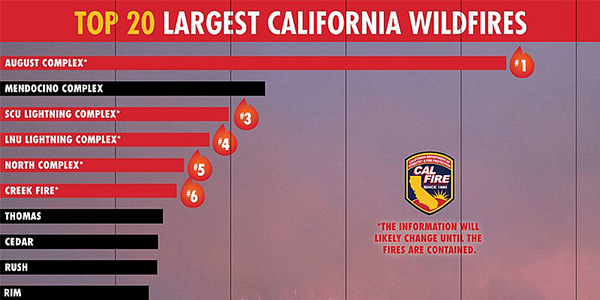Unfortunately, wildfire season is becoming a way of life in the Western U.S. and for their electric utilities.
The region suffered through a near record season this year. August thunderstorms that continued into September, strong winds, and hot, dry conditions combined to burn more than 8.2 million acres and kill more than 37 people in California, Oregon and Washington. The region saw the most megafires — blazes that char more than 100,000 acres — since 2008, with California recording five of its six largest fires ever.
Heather Rosentrater, senior vice president of energy delivery and shared services for Spokane, Wash.-based Avista, is not surprised.
“Wildfire risk for us has been the No. 1 risk on our enterprise risk register as long as I’ve been at Avista,” Rosentrater, who joined the company in 1996, said during a Critical Infrastructure Committee meeting last week during the National Association of Regulatory Utility Commissioners’ Annual Meeting and Education Conference.
Washington’s Department of Natural Resources responded to a decade-high 1,851 fires during this year’s fire season, which typically lasts from April through October. The state’s fires burned more than 496,000 acres, the most since 2015.
“Last wildfire season was so devastating across the territory,” Rosentrater told the committee during its meeting Friday. “It’s not a new risk. We see the risk as increasing.”
Recognizing the challenge, Avista earlier this year released a comprehensive 10-year Wildfire Resiliency Plan that includes improved defense strategies and operating practices and a capital cost of $270 million. The company, which also has a presence in neighboring Idaho and Montana, says the plan builds on prevention and response strategies it has had in place for many years.
It took Avista a year to develop the plan through a series of internal workshops, industry research and engagement with state and local fire agencies.
The company took a comprehensive look at its existing wildfire defenses and considered each tactic individually to determine whether it could be expanded or improved. Improving Avista’s infrastructure and operational practices were identified as the plan’s key components.
“We normalized the plan in early 2020 before the wildfire season started,” Rosentrater said. “We recognize that wildfires start from a number of areas, so we’re working to reduce the risk that our infrastructure starts any fires.”
The plan’s recommendations are focused in key areas:
- Grid hardening with fire-resilient materials and the addition of fiberglass cross-arms to reduce the likelihood of spark-ignition sources. Aerial surveys will strengthen power-line inspections.
- Vegetation management by increasing oversight of fire-prone areas.
- Situational awareness will be improved by leveraging current systems to better monitor and control the grid, improving operational decisions in the process.
- Operations and emergency response by physically patrolling outage areas during severe conditions before re-energizing distribution lines. Avista personnel will undergo advanced training and simulation so they can better work with fire professionals during wildfires.
- Strengthening worker and public safety through partnerships with emergency first responders and by incorporating designated Avista personnel into the company’s incident command system.
“There’s no silver bullet to wildfire-risk mitigation,” Rosentrater said. “We see this process as a process of continuous improvement. We recognize we’ll continue to learn and continue to apply new opportunities.”
Not included in the plan, she made sure to point out, was a risk analysis of proactive, pre-emptive power shutoffs like those California utilities are now using during fire season.
“It’s a top-of-the-mind topic for us on the West Coast,” Rosentrater said. “We recognize it has its own risks and challenges. … We don’t currently have pre-emptive shutoffs as part of our plan.”
Asked whether the tone is shifting in Avista’s footprint, Rosentrater said it is.
“We’ve been visiting with community leaders in the devastated area,” she said. “If you had asked us a couple of months ago [if we would] be supportive of proactive outages, we would have said, ‘No way.’ Not after this [season]. Starting those conversations with community leaders helped us understand those perspectives.”






